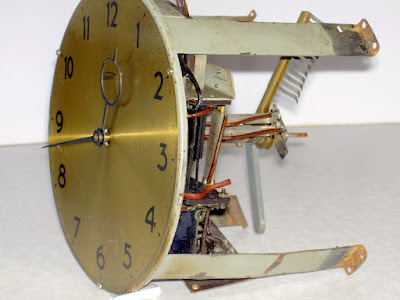*
I was contacted by the owner of this clock who kindly provided me with the following images. The owner was hoping for a valuation but these clocks are so rare that it would be impossible to suggest a value considering the generally low prices for Telavox clocks in Denmark. It may appear one day on eBay if my suggestion is followed. The plain dial suggests an early clock. What an attractive case with boxwood stringing against the dark veneer adding an extra touch of quality.
The plain dial suggests an early clock. What an attractive case with boxwood stringing against the dark veneer adding an extra touch of quality. The fascinating "programmer" style backplate with outlet socket on the left.
The fascinating "programmer" style backplate with outlet socket on the left. The underside of the case.
The underside of the case.
The unique label on the underside translates roughly into:
Voltage as marked. Current maximum 2 Amps.

And, a vital date stamp too confirm when it was manufactured. So few Telavox clocks were date stamped that I wonder whether these stamps might be the mark of a special factory quality inspection. Pure speculation on my part but I wonder why so few were stamped during manufacture. Some of these date stamps would have been impossible to manage once the clock case was completed. For example: Date stamps inside the case and even in the battery compartment. Some clock repairers marked clocks as they passed through their hands but I don't think repairers were responsible for making these particular date stamps.
These images kindly provided by the owner, though very clear, are a little too small to allow enlargement by clicking on them.
And yet another time clock: Note the mains lead.
The concentric perforated tracks where pins may be inserted to achieve a timed contact.
My thanks go to Graham for these images. It is interesting to see such a close agreement between the dates of these two clock timers.
And now a series series of superb images of the "innards" of the clock timer kindly provided by the new owner:
As confirmed by the mains lead in the earlier images this is indeed a synchronous motor driven device rather than the usual Telavox torsion pendulum movement.
The apparent complexity of the synchronous motor is simply a reduction gear train.
Electro-mechanical complexity hidden behind an innocent Telavox dial.
A clear view of the contact comb which rotates under the clock back plate.
The "comb" of contacts engages with pins selectively placed in the holes in the clock back plate. The socket for the timing device is on the right. Normally this would be fixed to the back of the case.
I am indebted to the new owner of this clock timer for dismantling his new possession and providing these fine images.
Yet another series of photographs of a clock timer but now of the torsion pendulum movement model.
The early, non-striking, Telavox torsion pendulum movement should run on a very large 3V battery. One which is now (probably) obsolete or simply unavailable. One wonders whether the characteristics of the large battery were important to the movement's design?
Ingenuity and apparent complexity hidden within a tastefully veneered, mantle clock case.
An overall view of this amazing mechanism.
A close-up of the solenoid, Telavox torsion balance and rate adjusting clip. (right at the bottom of the suspension spring)
I am most grateful to finally have a view inside a Telavox clock timer. To be provided with such excellent images of both the torsion pendulum model and the synchronous motor model is invaluable. I am still unsure which name to apply to these fascinating, electro-mechanical devices. Time clock, clock-timer or programmer? I have yet to fathom out the purpose of the various components beyond that of the contact comb and back plate.
All images may be enlarged by left clicking on them. Back click to return to the text.
*















No comments:
Post a Comment